
Minoan Plumbing at Knossos
Minoan Toilets, Drains, and Water Pipes
Knossos or
Κνωσός
has been called the first European city.
And in the second millennium BCE
this very first European city had flush toilets,
clean water supply lines,
and a sophisticated drainage system that separated
septic waste from rain water run off.
The Knossos site was settled around 7000 BCE
in the Neolithic period.
By about 2000 BCE it had become an urban area of
up to 18,000 people.
At its peak shortly after 1700 BCE, the population of the
complex and the surrounding city had grown to about 100,000.
DNA studies indicate that the people had a genetic
connection to the people of central and southern Greece.
But, we don't know what these people called themselves,
or what their language (or maybe languages) were like.
We call them "Minoan" because that
matches up with myths recorded significantly later.
We knew the name Knossos from the writings of Hesiod and Homer.
In the mid 20th century we finally figured out how to
read its name in the Linear B syllabary script
used for Mycenaean Greek:
𐀒𐀜𐀰
is KO-NO-SO.
The Knossos palace complex was abandoned in the Late
Bronze Age, around 1380–1100 BCE,
and the Mycenaeans (the Greeks in the story of the
Trojan War) took control of the site and other former
Minoan sites and trade routes.
You can take bus #2 from central Heraklion to
the Knossos site for just €1.50 each way.
Knossos
Μίνως Καλοκαιρινός or Minos Kalokairinos, an amateur archaeologist, discovered the site in 1878.
Along came Arthur Evans, eventually to become Sir Arthur John Evans. It was a different and much earlier time in archaeology and science in general. If you think Dr Henry "Indiana" Jones was reckless and sometimes unethical, get a load of this guy. Evans applied his personal assumptions and opinions on Knossos, its people, and their culture. His hypotheses were based on the art of Renaissance Italy and ancient Egypt, on languages and scripts of the Levant and Anatolia, and most dangerously, on some of the more ancient myths.
Evans had become Keeper of the Ashmolean Museum at Oxford. Through some shrewd moves (meaning misleading and barely legal) he personally purchased the two-hectare site of Knossos while the Ottoman Empire was crumbling. When the Ottoman control of Crete ended, Evans owned Knossos.
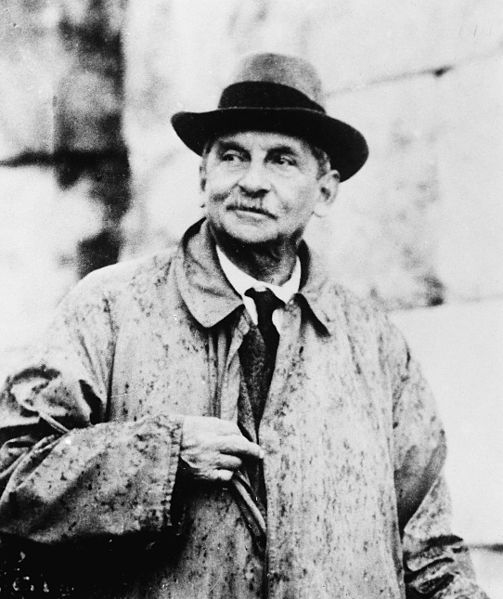
Sir Arthur John Evans.
Evans's Excavations, Assumptions, and Reconstructions
Arthur Evans began his excavations at Knossos in March 1900. Within a few months they realized that they were uncovering an intricately interconnected three-dimensional network of over 1,000 rooms on at least three to four levels. Evans called this a "palace", although some of it was artisans' workshops, food processing spaces, and religious and, presumably, administrative spaces. The initial excavation continued through 1903. Evans and his team kept working here through 1935. Research and conservation continue today.
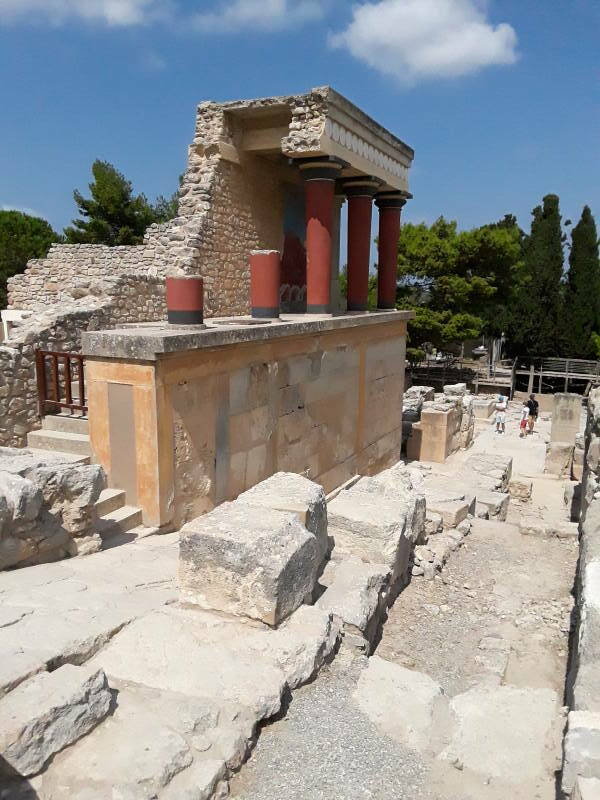
Arthur Evans's imaginative reconstructions at Knossos. Many of the details are based on his assumptions.
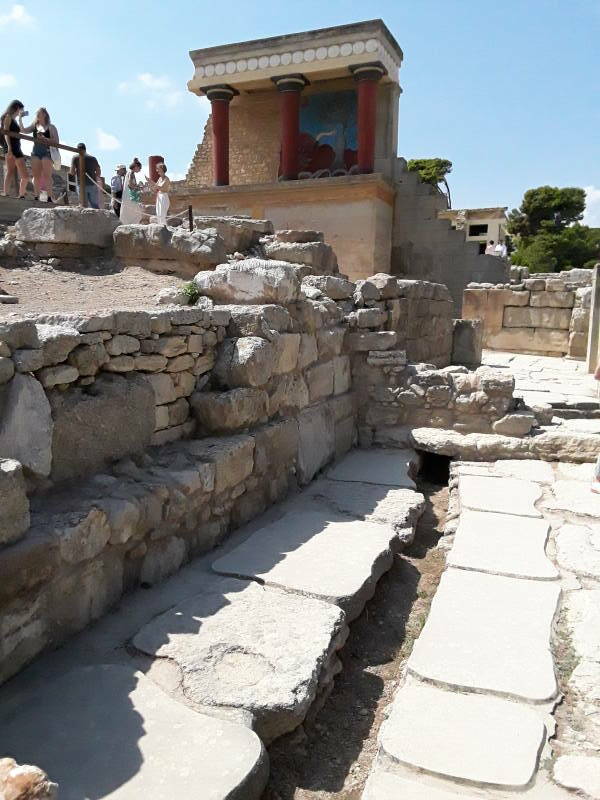
An authentic Minoan drain just below the most prominent palace reconstruction at Knossos.
Based on ceramic styles, failing to match them to anything known from Greece but finding apparent parallels to pieces from the Levant and Egypt, Evans concluded that this civilization on Crete had existed before the Mycenaeans.
The maze-like quality made Evans think of the labyrinth of Greek myth. Homer had described Minos as the king of Knossos on Crete in his Iliad and Odyssey. The myths tells us that Minos' wife Pasiphaë was more than just bovine-curious, she had a definite thing for bulls. A sexual thing. It had something to do with Minos once failing to sacrifice an especially fine bull to Poseidon, leading to Poseidon cursing Minos by giving his wife this weird obsession.
1: Even if you discount all the times that it was really Zeus in disguise, Greek myth features a lot of zoophila, to use a Greek-derived term.
Pasiphaë had Daedalus, the king's dangerously imaginative inventor, build her a wooden cow that she could hide within. A bull would mate with this apparent cow, and really be mating with Pasiphaë.1 Ouch.
The bull impregnated Pasiphë and the hideous result was the half-man half-bull Minotaur. Minos didn't want people to know the Minotaur's origins or even of its existence, and can you blame him? So, he had Daedalus devise a complicated underground maze. He then locked the monstrous Minotaur, and Daedalus, and his son Icarus inside it. Daedalus and Icarus escaped, of course, using yet another dangerous invention of Daedalus.
Evans concluded that obviously the Knossos complex was the palace of King Minos. And therefore the people who built and occupied it must be the Minoans.
The reality is that we have no idea what they called themselves. Or even what their language was like.
Lustral Basins
Evans's team found several examples of a sunken rectangular space accessed by an L-shaped or multi-turn stairway. Many had a balustrade alongside the stairway, ending with a pilaster supporting a column. The floor of the basin is always significantly lower than the surrounding floor.
Evans believed that these spaces were used for ritual bathing, or purification through lustration, and so he called them lustral basins. Here's a largely reconstructed example at Knossos:
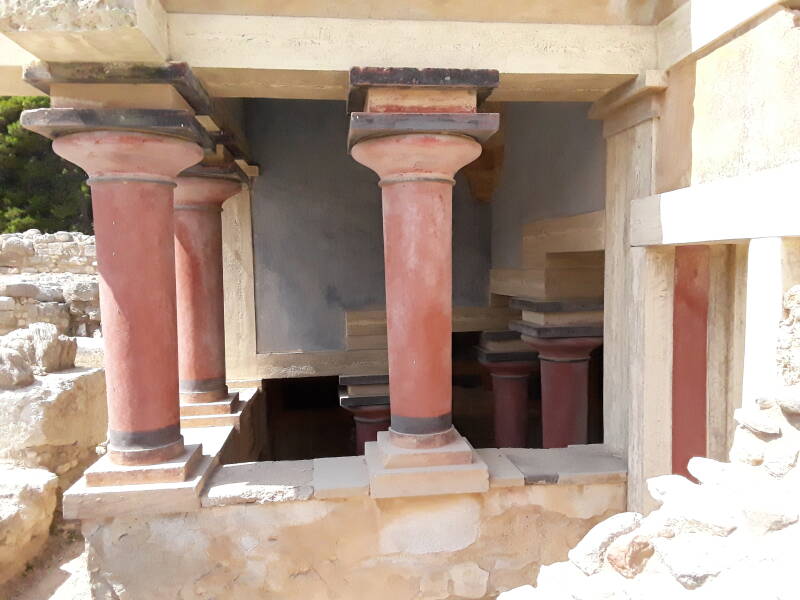
You'll notice that Cretan columns have an "upside-down" taper, wider at the top than the bottom.
One glaring problem is that all of the lustral basin examples at Knossos, and many of those at other Minoan sites across Crete, are lined with gypsum. That's a somewhat water soluble mineral, a very poor material for lining a bathing chamber. It's the main component of blackboard chalk, drywall, and many forms of plaster. It's useful for those applications, but not at all good for lining a water tub or tank.
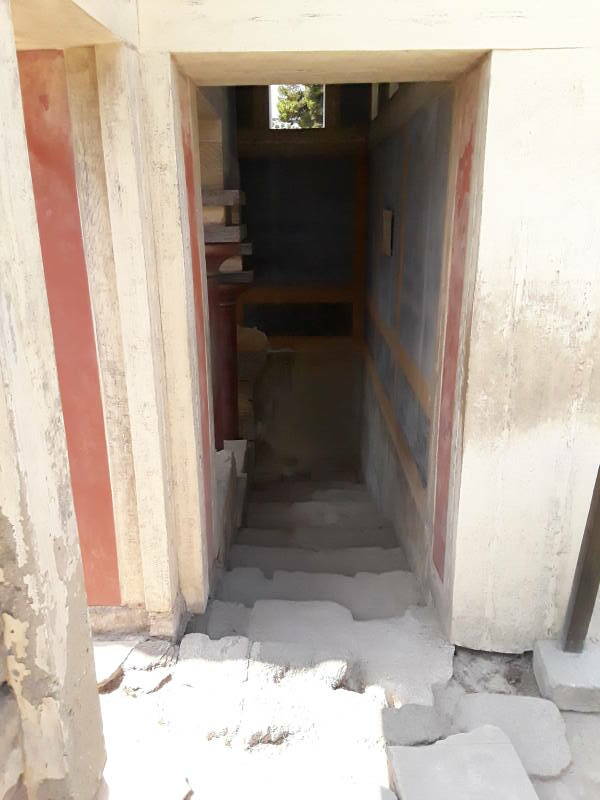
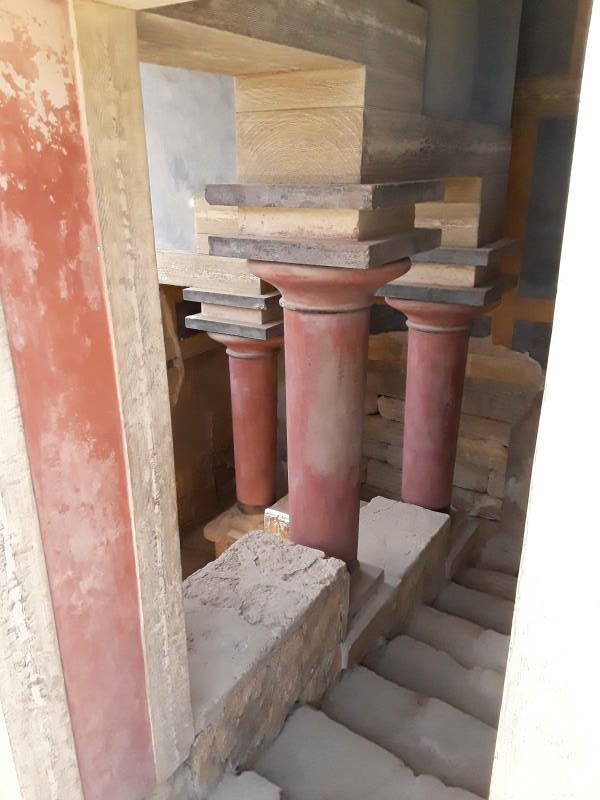
Another big problem is that none of these sunken spaces have drains. The Knossos complex and other Minoan sites in Crete are famous for their surprisingly advanced plumbing, both supplies and drains. The lack of plumbing at these so-called lustral basins strong suggests that they weren't water tubs or tanks, ceremonial or otherwise.
Many lustral basins throughout Crete and at the Cycladic but Minoan-influenced Akrotiri site on Thira or Θήρα were found to contain cult objects. Some contained offering tables or sacred vessels. The walls of some were decorated with religious themes. These structures could have to do with a chthonic or underworld deity associated with the renewal of nature. Many current scholars prefer the term adyton or άδυτον for these spaces, a Greek term meaning "off limits", referring to the most holy part of a temple of Classical Greek times.
2: Dario Puglisi, "Ritual performances in Minoan lustral basins: new observations on an old hypothesis", in Annuario della Scuola Archeologica di Atene e delle Missioni Italiane in Oriente, vol XC serie III, 12 2012.
Dario Puglisi's paper2 points out that the frescoes in the Xesté 3 lustral basin at the heavily Minoan-influenced Akrotiri site on Thira depict a female rite of passage. So, this might have also been their use in sites in Crete.
Another problematic lustral basin is in what Evans called the Throne Room at Knossos.
It's not a very grand throne room for such an impressive complex. Yes, there is an alabaster chair along one wall, with gypsum benches for some henchmen to either side, and a medium sized stone bowl. But is this the throne room of an empire that controlled trade all around the eastern Mediterranean at its peak?
And then the frescoes...
Many authors have complained that Evans and his restorers were not discovering the complex and its civilization as it really was, but instead they were creating a modern artifact based on the art and architecture of their own time. "Minoan civilization as it should have been", or something like that.
The frescos at Knossos were very fragmentary. The vast majority of what you see today is an imaginative "reconstruction" or really de novo creation by Evans and his staff. Evans had a father-and-son team of Swiss artists, Émile Gilléron pers et fils, recreate the frescoes. It's believed now that almost all of the frescos you see today are simply their invention guided by suggestions from Evans.
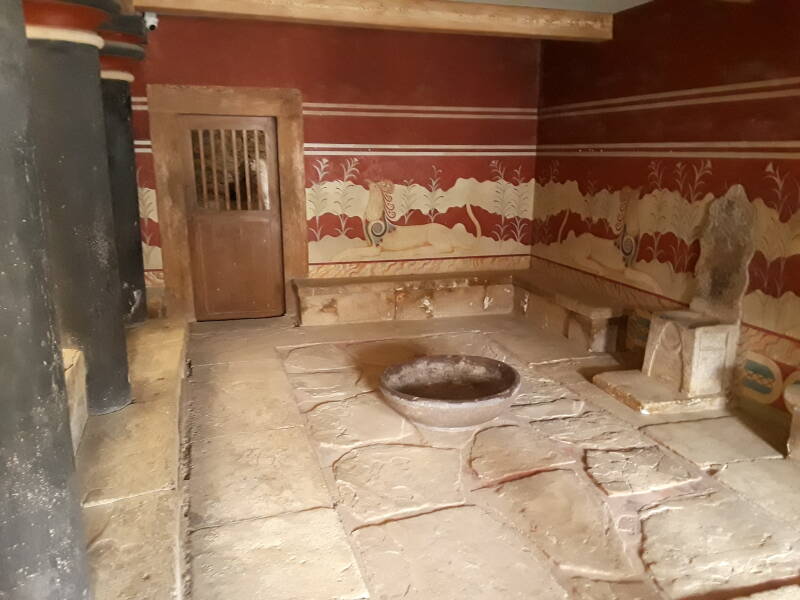
The supposed throne looks across the small room, over the stone bowl to the lustral basin. Did the ruler — now believed at least as likely to have been a queen rather than a king — simply sit there and watch a ritual? Or did the ruler cross the room and enter the lustral basin? And if so, what happened then? No one has any idea.
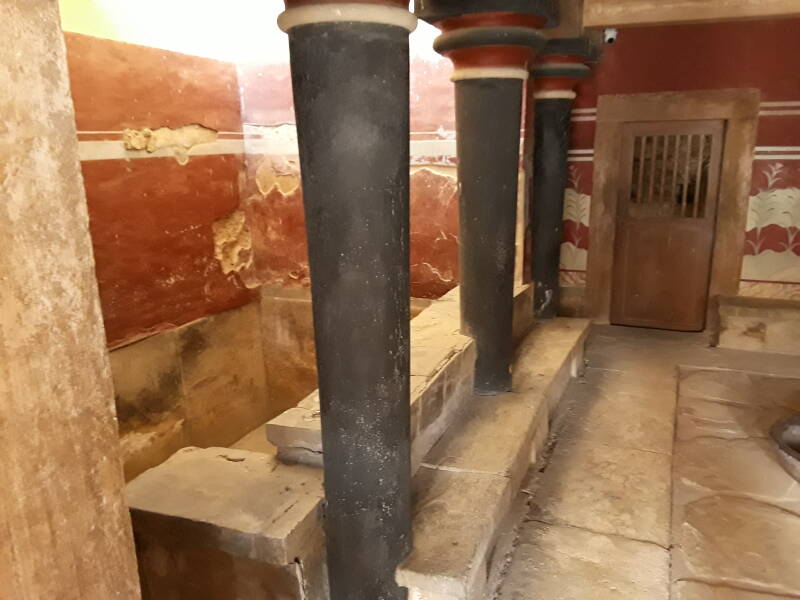
Let's See Some Real Minoan Plumbing!
There's no end to finding skepticism about the assumptions and conclusions of Arthur Evans and other early archaeologists.
But it's obvious that the Minoans — for lack of a solid name — had extremely impressive plumbing for their time.
What you see today at Knossos and other Minoan sites has to be a cross-section of eras. The Knossos site began with a small Neolithic settlement of 25–50 people around 7000 BCE. That grew to about 200–600 people by the Early Neolithic of 6000–5000 BCE, and 500–1000 by the Middle Neolithic of 5000–4000 BCE.
The first "palace" complexes were built soon after roughly 2000 BCE. These were destroyed, almost certainly by earthquakes, before roughly 1700 BCE.
The palace complexes were rebuilt on a grander scale, leading to about 1650–1450 BCE being the peak of Minoan prosperity and power. The settlements of all these periods were built on top of each other.
Below, as we enter across the Western Court, one of the first things we see is a drain in the western approach to the complex.
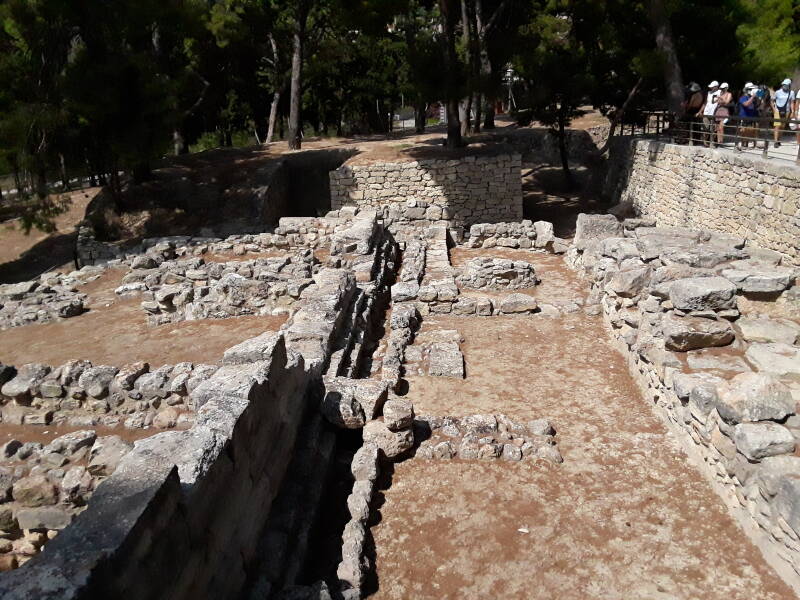
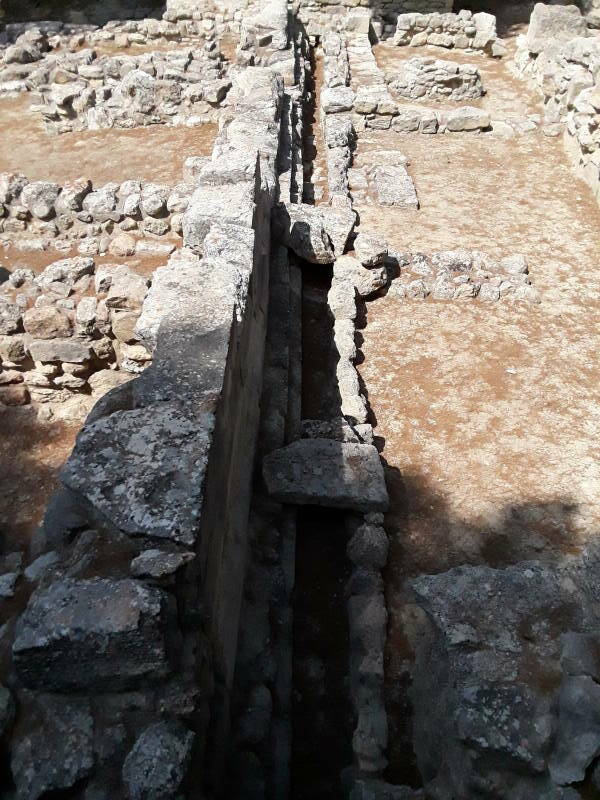
The Queen's Toilet
The most famous piece of plumbing at Knossos is the Queen's Toilet. While famous, is seems to be inaccurately known. A prominent guide book places it in the wrong room, and the modern restoration has it in the correct room but on the wrong wall! Let's see the original toilet, and learn where it really was.
Below we're looking down three levels from the east edge of the Central Court into part of a large area called the Domestic Quarter. East is toward the top of the picture. We're looking down into an area that contained the Queen's Toilet, according to the usually authoritative Blue Guide for Crete. If that were true, the toilet would be the square hole along the far side of that lower rectangular space.
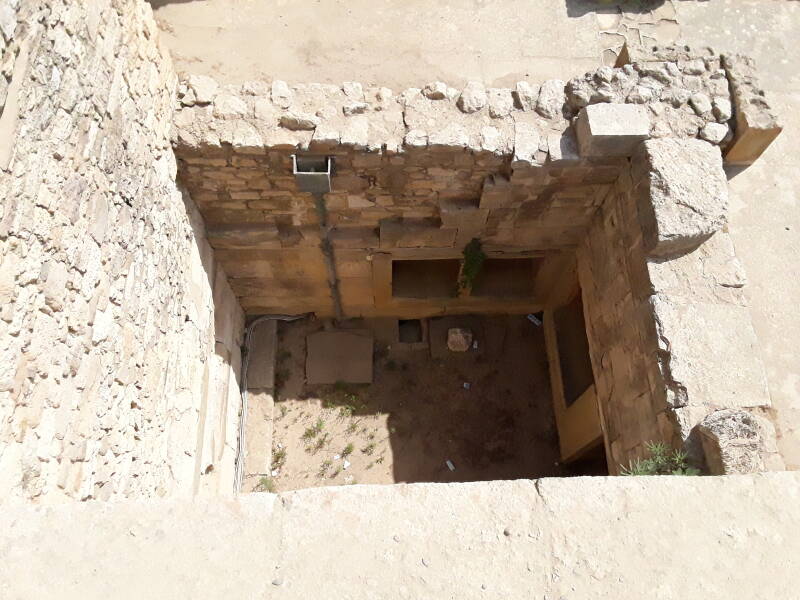
That isn't a toilet. It is a drain, but it's for rain water. We're looking down from the Central Court, standing at the level of the Throne Room. We're looking into the Court of the Distaffs, a light well that was open to the sky. Its floor is three levels below the Central Court. The surrounding area visible above and to the right in this picture is a domestic area two levels below the central court.
Below we have moved a little to our right, to the south, and are looking diagonally toward the northeast across the Court of the Distaffs.
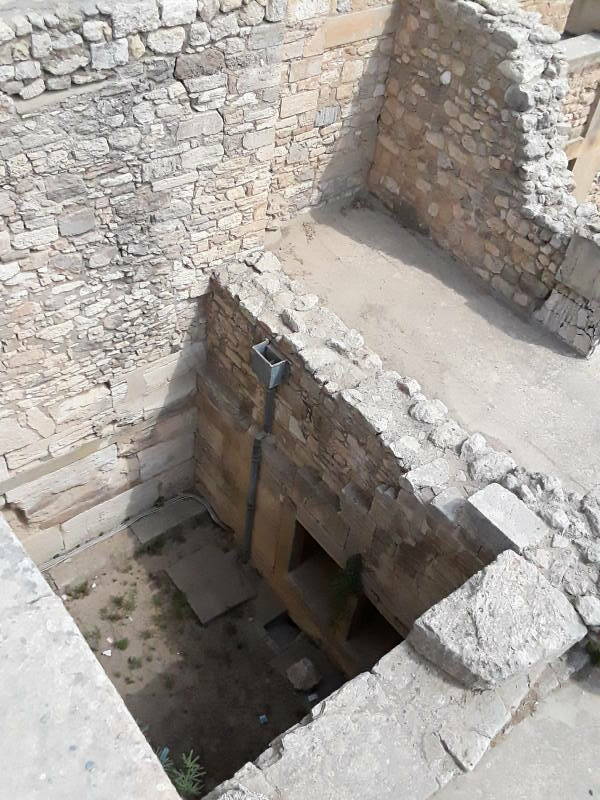
The actual Queen's toilet location is in the room on the south side of the Court of the Distaffs. The toilet is just below center in the picture below. It's the narrow channel to the left of the metal grate plus the opening covered by the grate. Again, east is at the top of the picture.
The rectangular blocks to either side of the left end of that channel door frames for the toilet. The channel extended slightly outside the closed doors. Water poured into the channel flushed the toilet. There was a gypsum floor over most of the square opening. A wooden seat left an opening between the rear of the seat and the back wall of the small chamber.
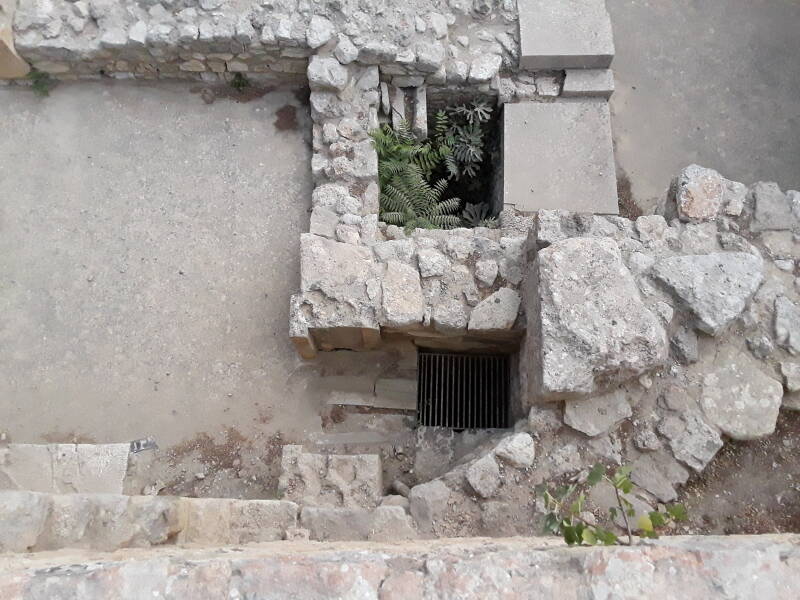
[1] Georgios P. Antoniou et al, Sustainability, vol. 8, no. 8, DOI:10.3390/su8080779.
The below photo from the University of North Carolina appeared in "Evolution of Toilets Worldwide through the Millennia" [1]. You can better see the channel projecting forward from the toilet's drain, and the bases of the door frame.
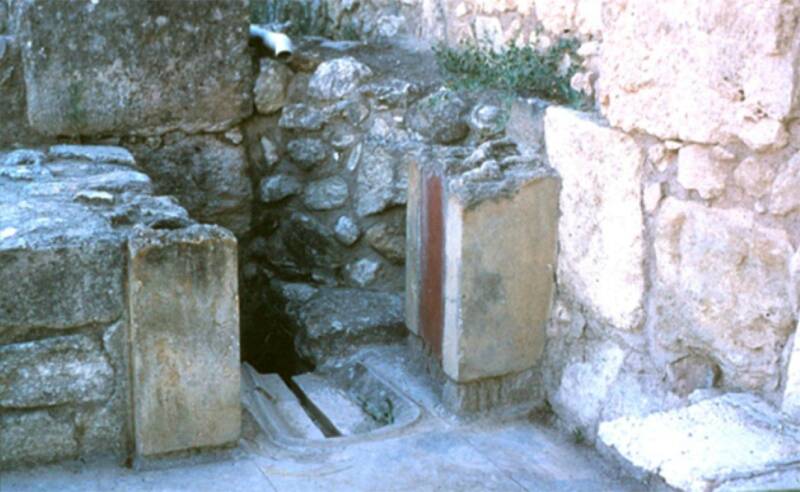
Back to my pictures, you can see the complex 3-D nature of the Knossos palace complex. We've been looking down two floors to the true Queen's Toilet, three levels to the spurious Blue Guide suggestion of that light well.
The three pictures below provide a better overall view of the flushing channel. It's near the bottom margin of each picture. In the first picture we're looking toward the east, seeing some additional palace space interpreted by Evans as the Queen's Apartment.
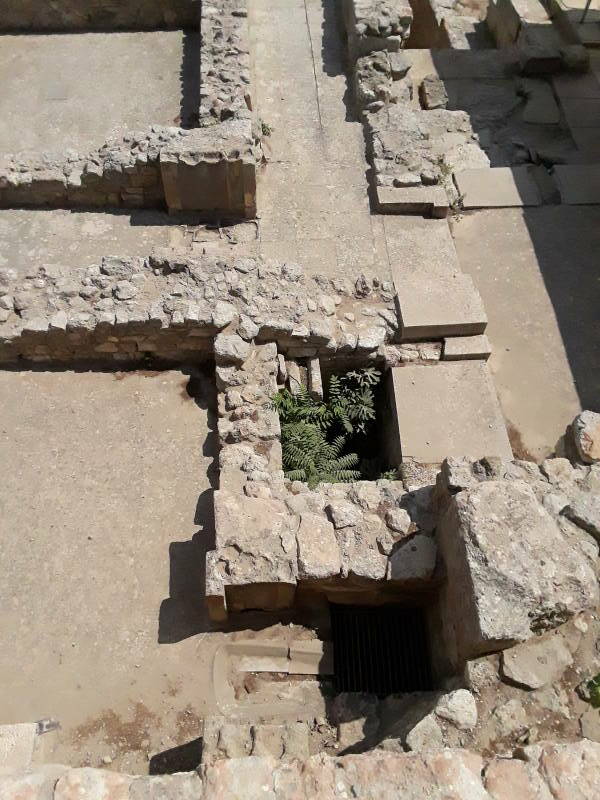
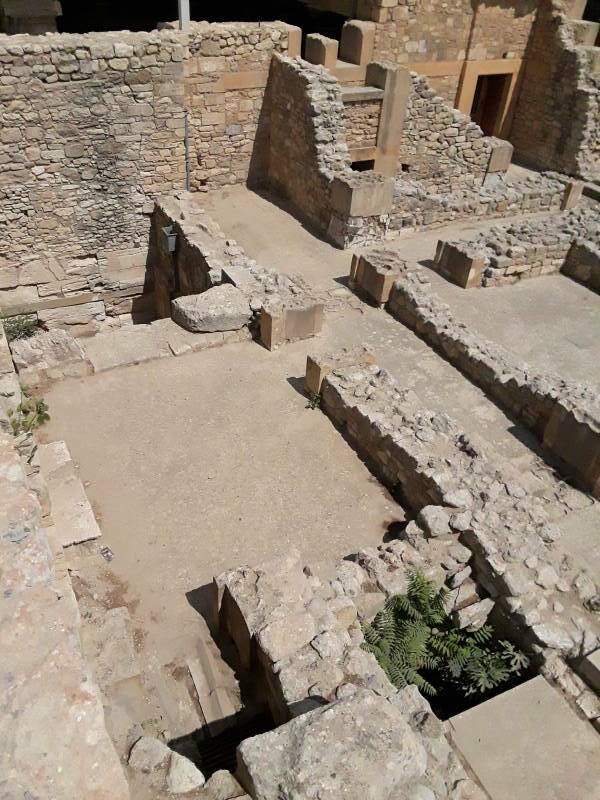
In the second picture above, we're looking north-northeast. The light well of the Court of the Distaffs is toward the upper left. Various rooms, passages, and staircases begin to come into view. There are over 150 meters of drain lines just under this domestic quarter.
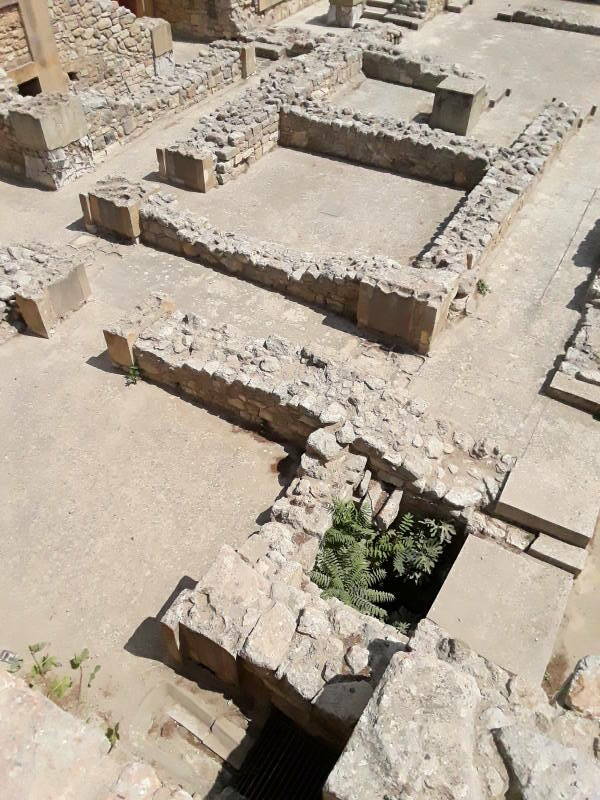
In the last picture above we're looking east-northeast over the Queen's Toilet, to a storeroom and what Evans interpreted as the Queen's Bathroom. This bathroom appears from here to have a cubical block near its center. It's in the upper right of this picture. That was a column base, at the end of a short narrow hallway. The actual bathroom is the rectangular area to the left of that cube. There's more on it further down this page.
Below is a cross-section and top-down plan view of the Queen's Toilet. A wooden seat was 55 to 57 cm above the floor. The seat heights were what led Evans to describe this area as the Queen's Apartment.
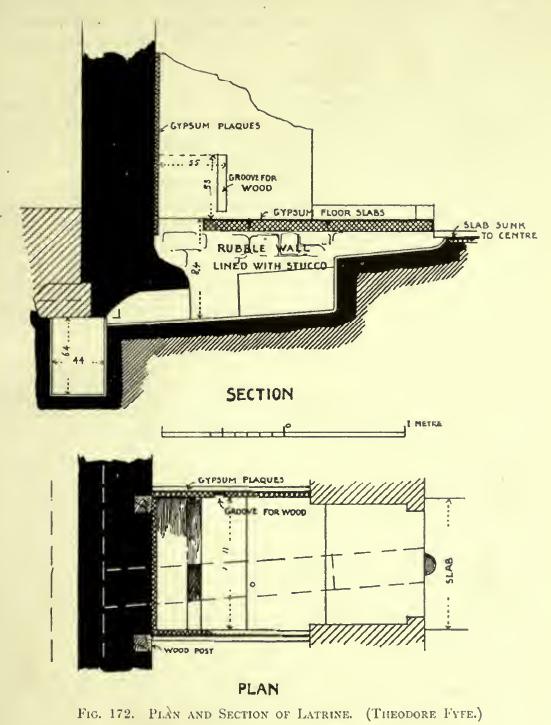
Figure 172, page 229 of The Palace of Minos at Knossos, Volume I, Sir Arthur John Evans.
A rooftop reservoir provided water for washing, even during an almost entirely rain-free summer.
The Palace of Minos at Knossos,
Sir Sir Arthur John Evans
Now for the toilet misplacement.
Below is Figure 249, from page 375 of The Palace of Minos at Knossos: Volume III, Sir Arthur John Evans, 1930, part of his multi-volume series of thick books describing Knosssos.
Unlike my pictures, taken from the Central Court looking toward the east, this diagram has west at the top. So, the Queen's Toilet is at the top. Or, Toilette as Evans called it. Queen Victoria had died just a few years before, in 1901, and terminology was still pointlessly squeamish. Elsewhere he mostly uses "toilet" to refer to a lady's process of dressing and preparation.
Evans's diagram shows that the toilet, labeled W.C., was on the center of the east wall, not at the west end of the south wall where we see it today.
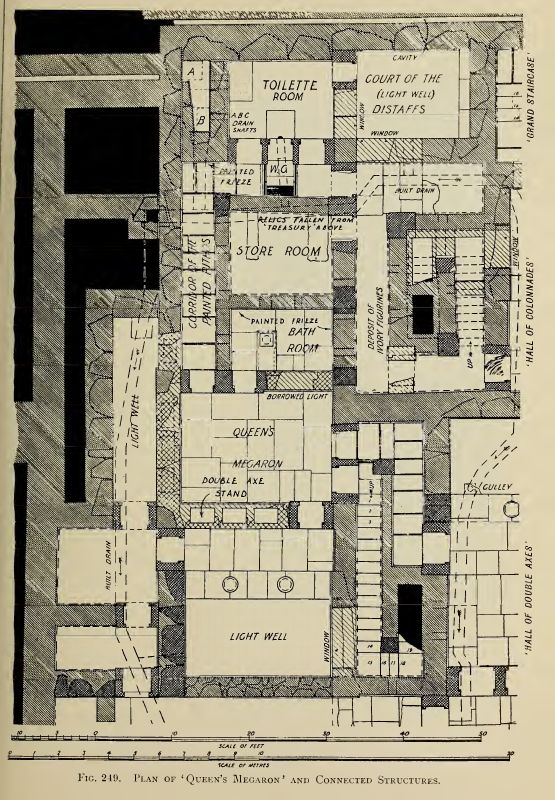
Figure 249, page 375, The Palace of Minos at Knossos, Volume III, Sir Arthur John Evans, 1930.
You can see "BATH ROOM" near the center of the above diagram. Below is a view from above, and a side view. The Queen would have bathed in a tub. Further down this page you will see some Minoan bath tubs.
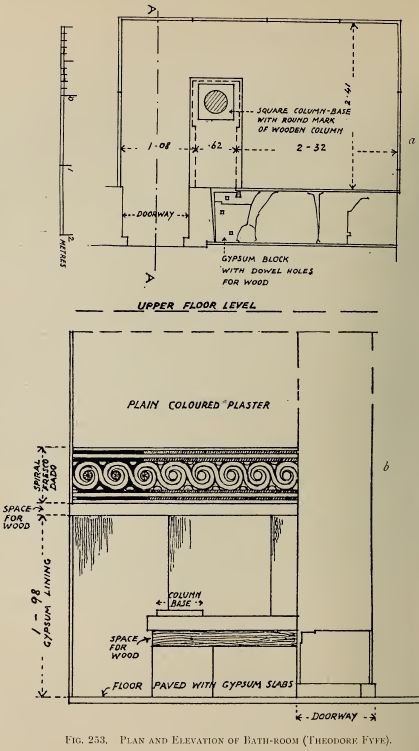
Figure 253, page 382, The Palace of Minos at Knossos, Volume III, Sir Arthur John Evans, 1930.
Below is a depiction of what the bathroom would have looked like, also from Evans's The Palace of Minos at Knossos: Volume III.
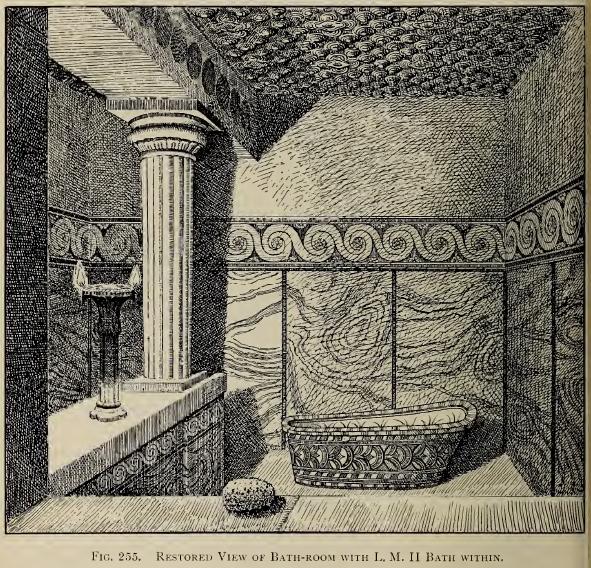
Figure 254, page 384, The Palace of Minos at Knossos, Volume III, Sir Arthur John Evans, 1930.
The below diagrams are from The Palace of Minos at Knossos: Volume III. The two top-down plans have north at the top. The cross-section is looking toward the north.
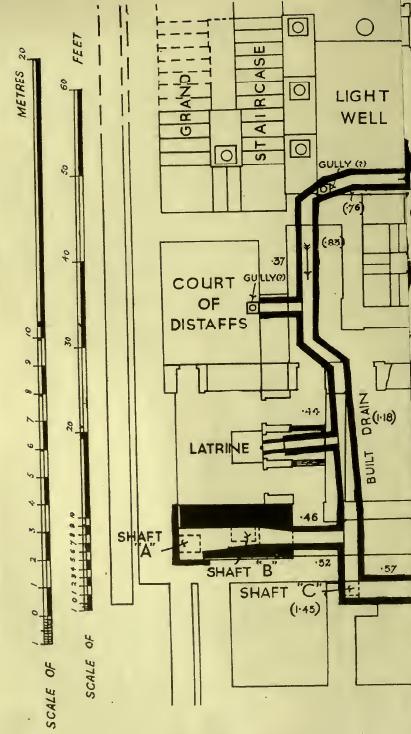
Figure 171a, page 227, The Palace of Minos at Knossos, Volume III, Sir Arthur John Evans, 1930.
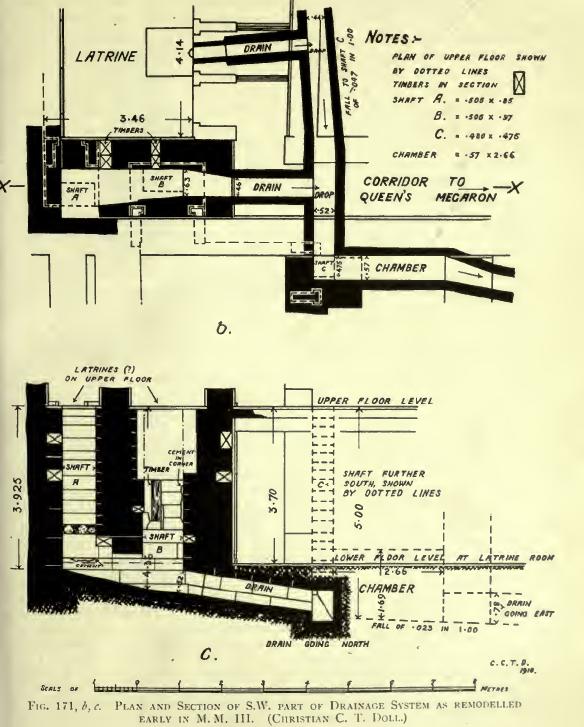
Figure 171b, 171c, page 227, The Palace of Minos at Knossos, Volume III, Sir Arthur John Evans, 1930.
Below is a diagram of the drainage system in this part of the Knossos palace. It appears in "The Storm Drains of Knossos" and "The Drainage System of the Domestic Quarter in the Palace at Knossos". The deep light well is labeled "Court of the Distaffs (LW)", The room with the toilet is labeled "Room of the Plaster Couch". It shows the toilet on the east wall, as documented by Evans, not the south wall as we see it today. See Figure 7 of the second paper, in which they do a block-by-block analysis of the drains, for more on the toilet's connection to the drains.
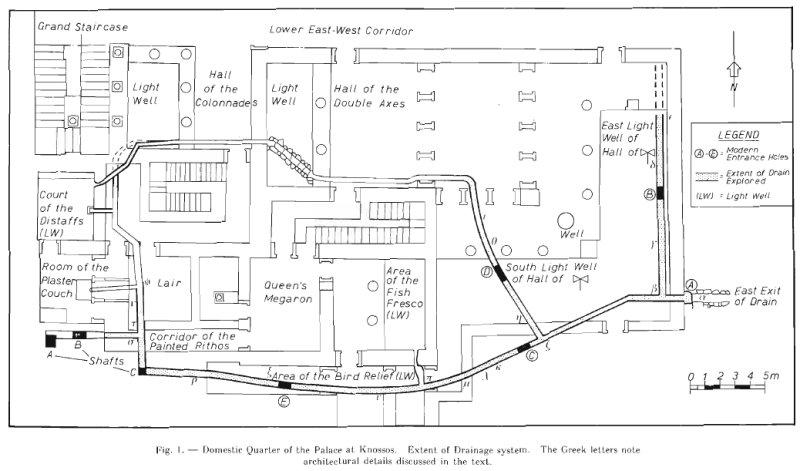
Today's reconstruction has moved the toilet to the other wall. My pictures above show that the reconstruction connects it to Shaft A. Their analysis suggests that Shafts A and B might have been dedicated to septic waste lines, and the palace complex was heavily damaged by earthquakes and rebuilt. So who knows, maybe a toilet was on the south wall at one time.
Archaeologists have found no public latrines at any Minoan sites. The homes had private toilets. This was very different from the later Greek civilization.
Water Supply Lines
Knossos famously had fresh water supply lines built from tapered clay pipes. Here is an example.
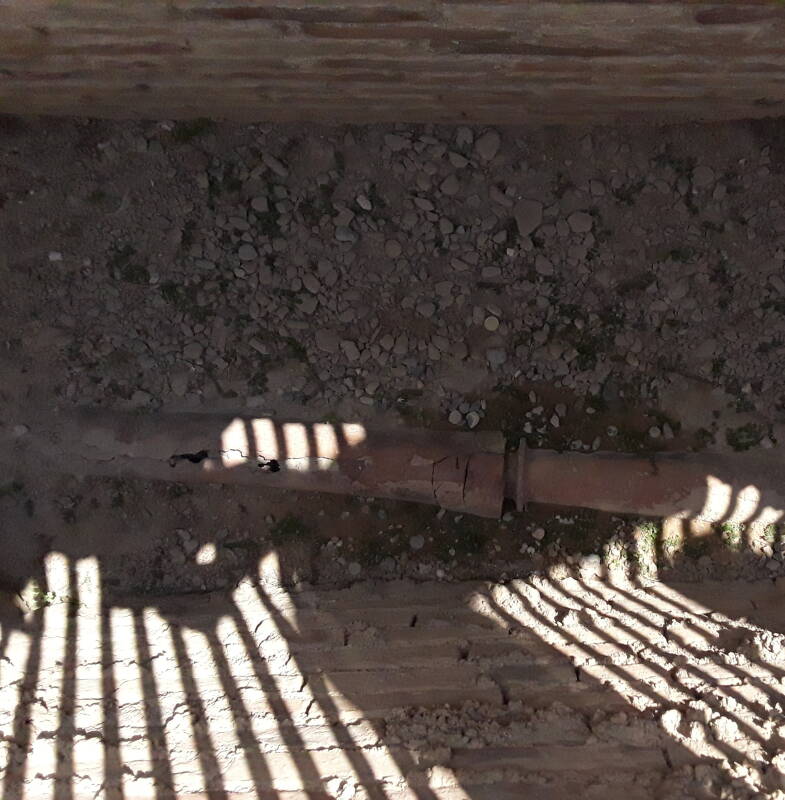
The below drawing with dimensions is also from The Palace of Minos at Knossos: Volume III. Standardized production meant for easy construction, maintenance, and modification. They were used so water flowed from the wider to the narrower end. Evans described them as "admirably designed to impart a shooting motion to the flow of water, so as to prevent the accumulation of sediment." Similarly shaped but much wider terracotta segments were used to line wells. Those had an inside diameter of 69 cm.
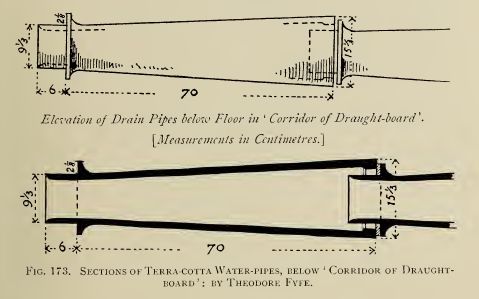
Figure 173, page 253, The Palace of Minos at Knossos: Volume III.
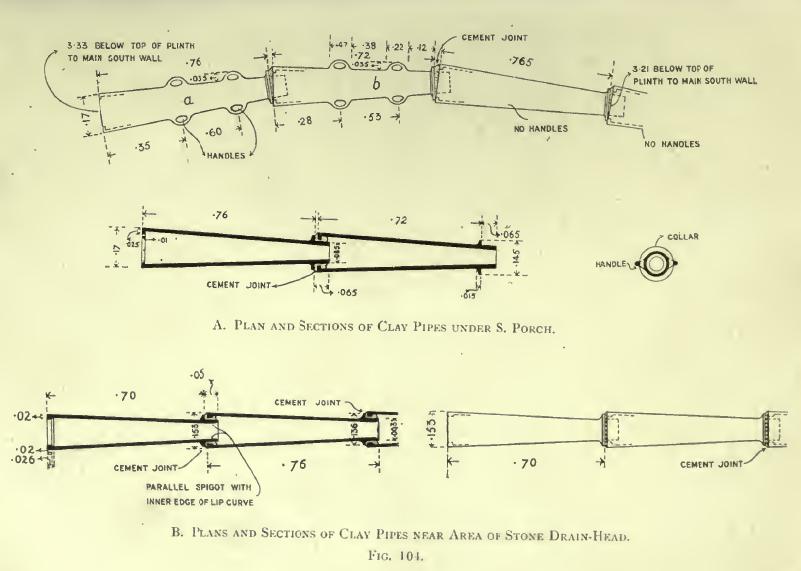
Figure 104, page 143, The Palace of Minos at Knossos: Volume I.
Separate Drains
Knossos had separate wastewater and storm drains.
That is, independent "sewer lines" and "storm water drains." Many cities in today's United States don't have this. In those cases, all septic wastewater and relatively clean rainwater runoff go into a unified drain system, meaning that raw or at least incompletely treated sewage is dumped into streams during periods of heavy rain.
Knossos had solved this problem before 1450 BCE by using drains like these.
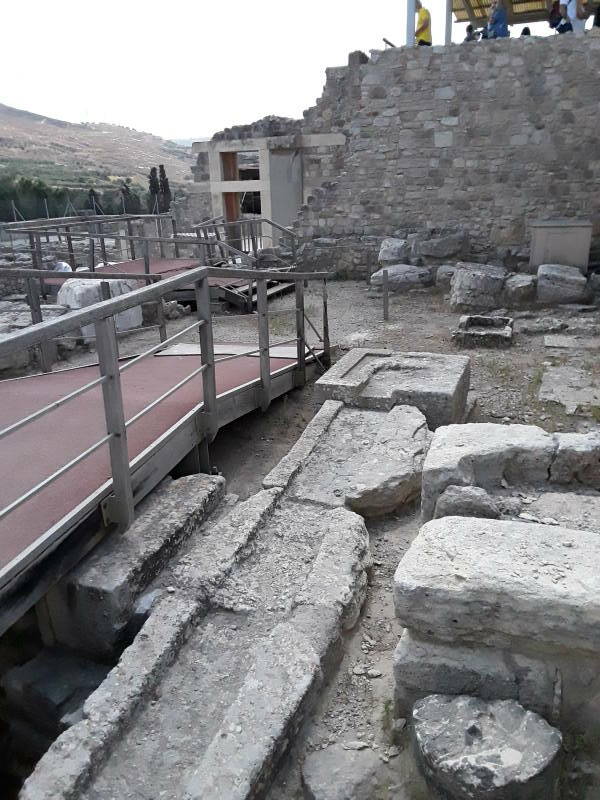
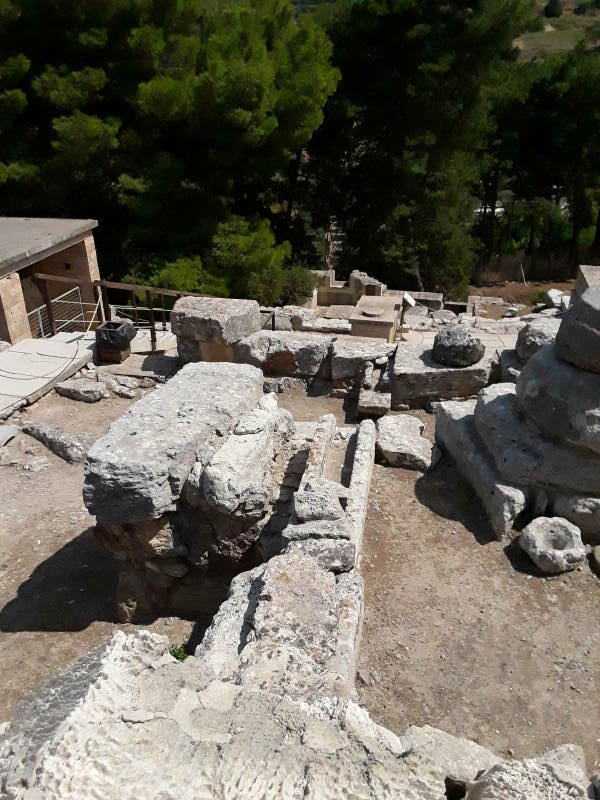
The Heraklion Archaeological Museum has a fantastic collection, including some Minoan bathtubs.
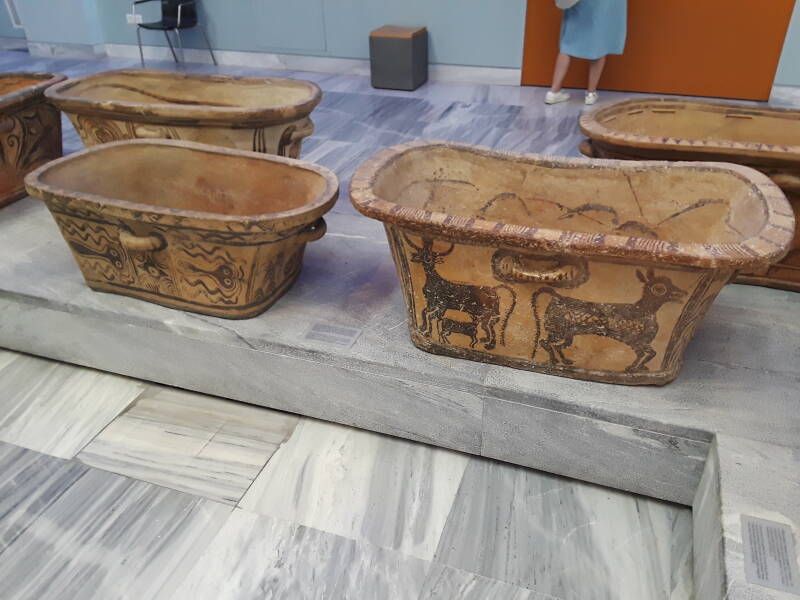
Or, there's an argument that it's actually a larnax or λάρναξ, a coffin to contain human remains. Or, that it was used as a bathtub while the owner was alive, and then used as a coffin.
Some of them have drains that could be stopped by a cork to fill the tub, then unstopped to empty it. They certainly were functional as bathtubs.
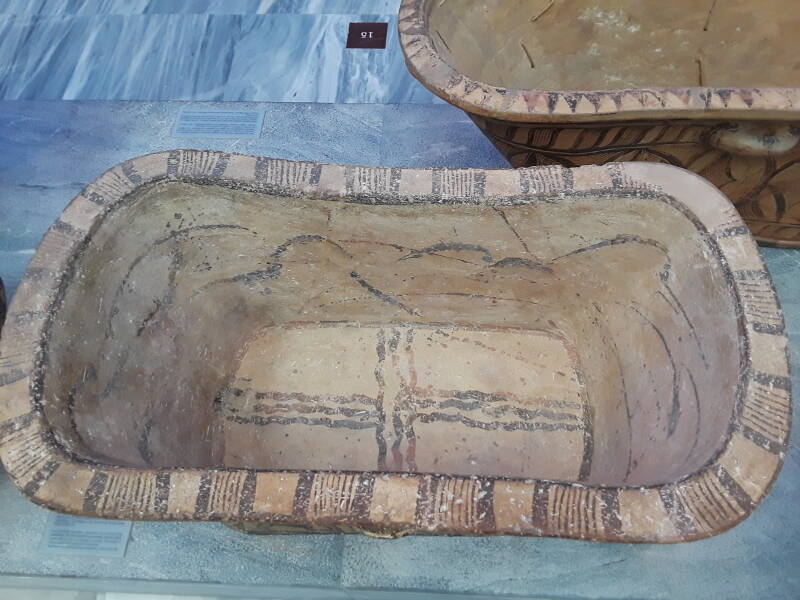
This one is decorated with octopuses.
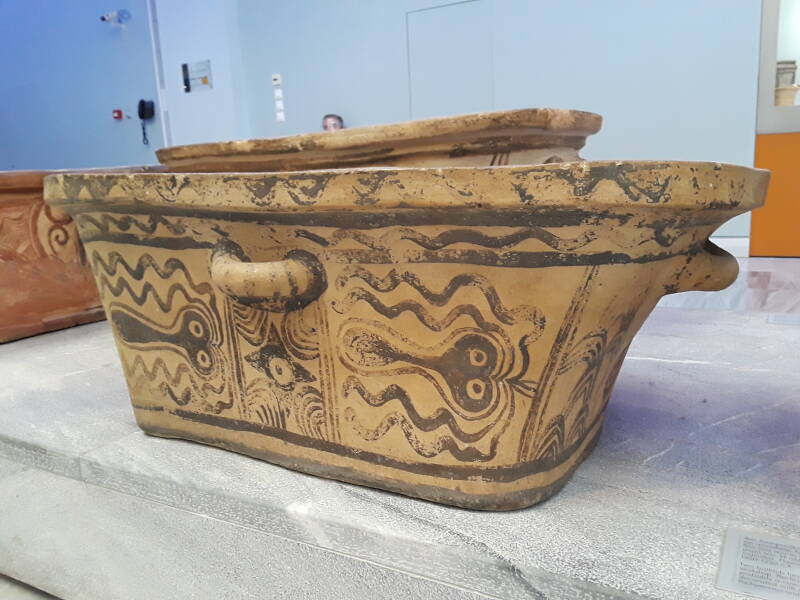
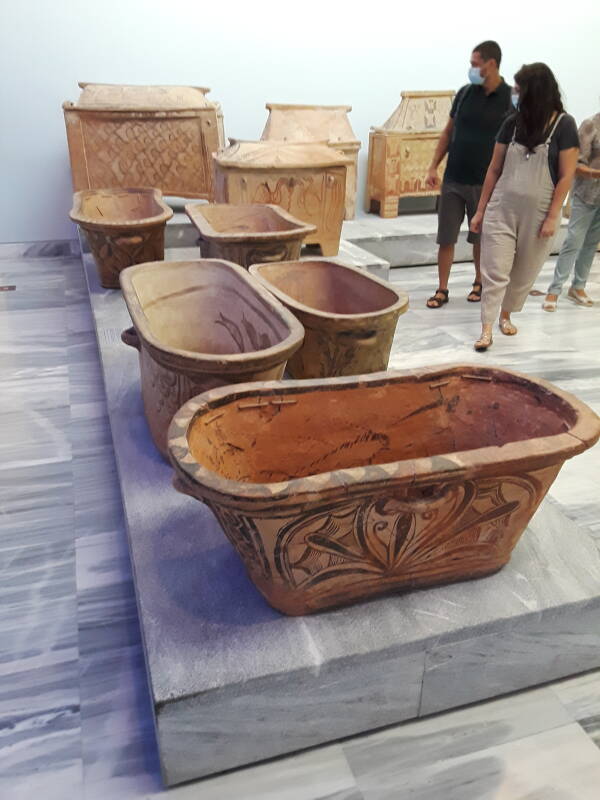
Fish scales outside, fish inside.
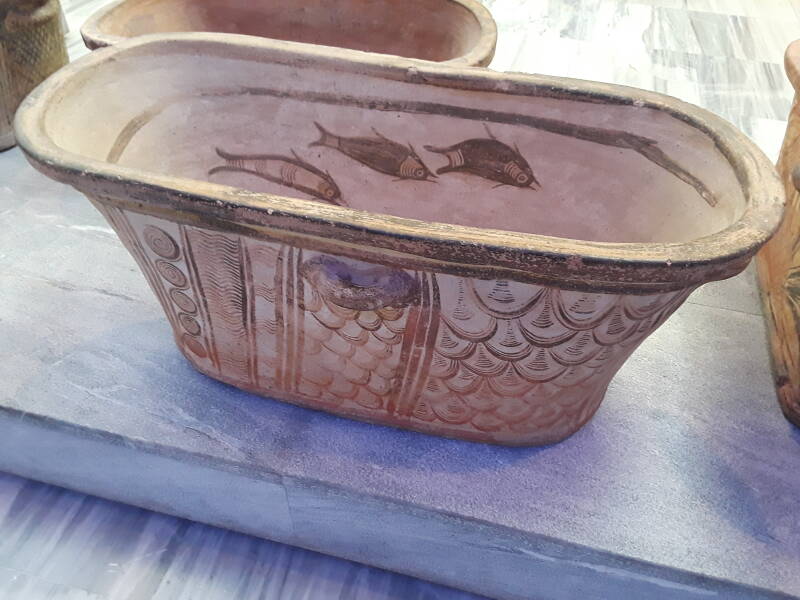
Finally, what can the modern tourist use at Knossos? Here's a public toilet at the Knossos palace site. As usual in Greece:
- No paper goes into the bowl, it must all go into the waste bin. See Bowl or Bin? for details.
- There will be a toilet brush for you to use to clean up after your messy #2.
- There very likely will not be a seat, because without a seat there's only an easy to completely clean (and, soothingly cool) vitreous or glass-like ceramic rim. See Seatless Toilets for more.
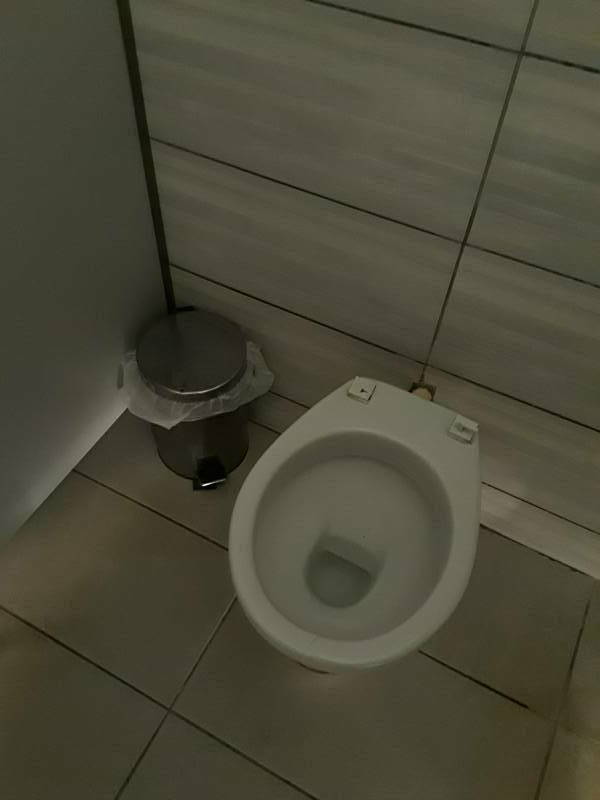
To investigate deeper:
The Storm Drains of Knossos
Jan Driessen,
Bulletin de Correspondance Hellénique
Supplement XIX,
L'Habitat Égéen
Préhistorique,
1990
The Drainage System in the East Wing at Knossos
C MacDonald and Jan Driessen
Evolution of Toilets Worldwide through the
Millennia
Georgios P. Antoniou et al,
Sustainability 2016, 8(8), 779;
https://doi.org/10.3390/su8080779
Check out another Minoan site in Crete:
More Minoan Toilets, Drains, and Water Lines
